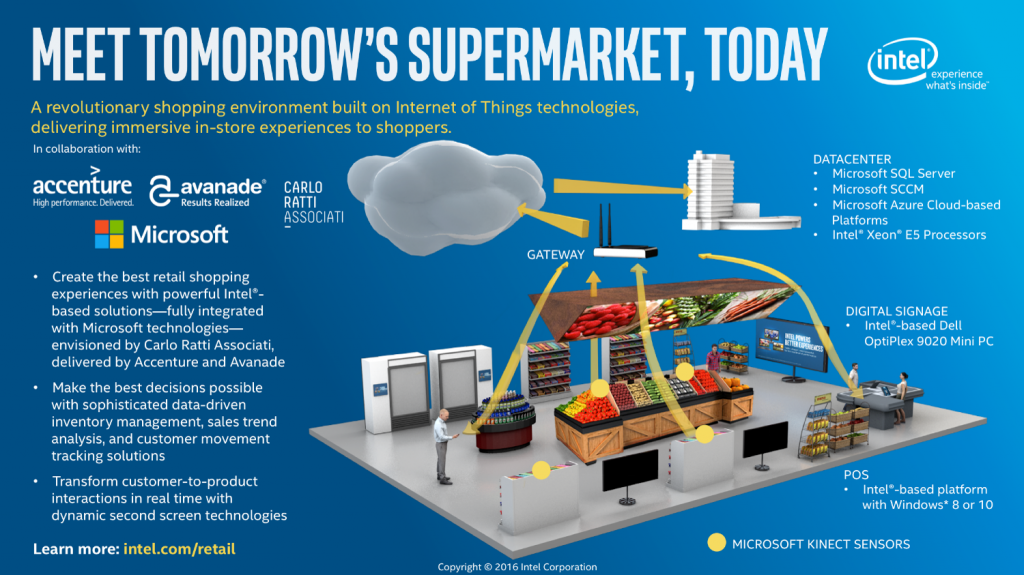The supermarket of the future: Designing for humans
Back to the future? More like forward to the past.
Italy’s biggest grocery cooperative is using futuristic technology to help shoppers return to the sociable days of open-air markets, when there were shopkeepers at every stall, ready to answer any question a customer might have about their wares.
Coop Italia’s “supermarket of the future,” designed by Carlo Ratti, has won rave reviews, thanks to a digital design that created a more human shopping experience using a range of off-the-shelf technology. The concept, which debuted at Expo Milan last year and will be showcased at Microsoft’s Envision conference this week, replaces the typical grocery store’s rows of towering shelves with an airy layout, including easy-to-reach, tilted displays and informative screens suspended at eye level.
Motion sensors detect which product a shopper is pointing or looking at, triggering visual displays of information such as ingredients, potential allergens, the origin or processing of the food, its carbon footprint, and even wine pairing recommendations. That’s exactly the sort of detail that consumers now see as a fundamental pillar of their shopping experience – especially millennials who grew up with the Internet at their fingertips. Coop Italia hopes the concept will help it grow in an increasingly competitive marketplace where brick-and-mortar stores have struggled to engage with shoppers.
“Customers now want access to everything there is to know about the products they are looking at,” says Gabriele Tubertini, Coop Italia’s chief information officer. “Take an apple, for example. They want to know what type of tree it grew on, the CO2 it produced, the chemical treatments it received, and what its journey was to the supermarket shelf.”
The large, easy-to-read screens providing that information mean shoppers don’t have to fumble with cumbersome devices, and older customers don’t have to get out their reading glasses.
“It’s like a return to the old marketplace, where producers and consumers of food could easily interact with each other, exchanging stories and ideas,” Tubertini says.
It’s a significant shift for the retailer as well. The system provides instantly updated information on shelf inventory, allowing Coop Italia to keep goods in a store warehouse, rather than on shelves, until items need to be replenished. This design frees up valuable store space to make the most of famed architect Carlo Ratti’s redesigned aisles and food displays. It also shows in real time which items are popular and gives insight into how shoppers make decisions and move about the store, Tubertini says. And it identifies what information is relevant and useful for consumers, which is guiding Coop Italia’s interactions with its vendors.
Smart merchants are not only expanding their categories to cater to new and changing customer behaviors, they’re also making way for a hybrid model of shopping that combines digital and in-person experiences, says Sahir Anand, an analyst with EKN Research.
“Retailers can win by combining hyper personalization, deep product information and connected devices in-line with customer buying journeys,” Anand says. “Retailers need to shape the future of supermarkets by offering customers a smarter and more efficient system of experiential and frictionless shopping.” (Learn more about how retail executives are using analytics and the cloud to stay relevant with today’s consumers.)
The “supermarket of the future” concept was developed by IT professional services firms and Microsoft partners Accenture and Avanade and relies on readily available technology. It uses sensors developed for Kinect, Microsoft’s motion-sensing camera that started out as an Xbox 360 game controller, with Intel NUCs providing computing power to the interactive shelves and displays; the data is stored on Microsoft Azure cloud-based platforms using the Microsoft SQL server relational database management system and Microsoft content management capabilities; and the cash registers run on an Intel-based platform with Microsoft Windows software.
More than 1.7 million people visited Coop Italia’s test store in Milan during the 2015 six-month world’s fair, experiencing how digital solutions and the Internet of Things have become game-changers in enhancing the shopping experience, says Tracy Issel, general manager of worldwide retail industry at Microsoft.
“This is a great example of how modern retailers are innovating to improve the human element, enjoyment and efficiency for their customers,” Issel says.
The concept store reinforced the importance of designing for humans rather than designing for technology’s sake, as consumers are increasingly shifting their focus from glitz to practicality, says John Konczal, Avanade’s industry director.
“The outcome was a more natural experience for the shopper,” Konczal says. “Digital tech changed the experience, but the customer didn’t have to do much differently — all they had to do was wave their hand.”
Coop Italia plans to use the knowledge gained from the “supermarket of the future” experiment to implement new layouts and digital solutions in its stores later this year, Tubertini says.
Top photo: Coop Italia’s “supermarket of the future” system identifies what product a customer is pointing to or looking at, thanks to Microsoft Kinect technology, and instantly displays a wealth of information.









